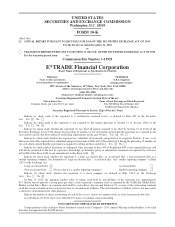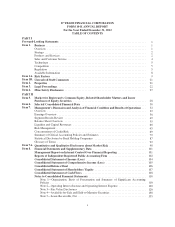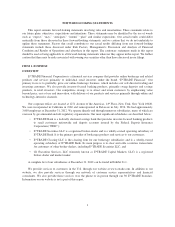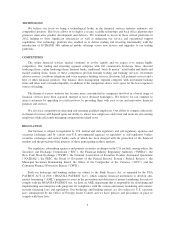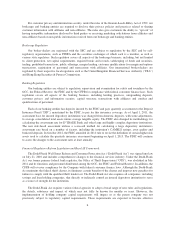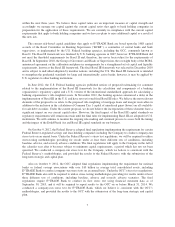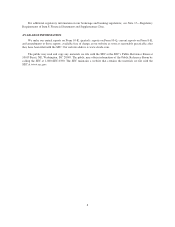eTrade 2012 Annual Report Download - page 9
Download and view the complete annual report
Please find page 9 of the 2012 eTrade annual report below. You can navigate through the pages in the report by either clicking on the pages listed below, or by using the keyword search tool below to find specific information within the annual report.For customer privacy and information security, under the rules of the Gramm-Leach-Bliley Act of 1999, our
brokerage and banking entities are required to disclose their privacy policies and practices related to sharing
customer information with affiliates and non-affiliates. The rules also give customers the ability to “opt out” of
having non-public information disclosed to third parties or receiving marketing solicitations from affiliates and
non-affiliates based on non-public information received from our brokerage and banking entities.
Brokerage Regulation
Our broker-dealers are registered with the SEC and are subject to regulation by the SEC and by self-
regulatory organizations, such as FINRA and the securities exchanges of which each is a member, as well as
various state regulators. Such regulation covers all aspects of the brokerage business, including, but not limited
to, client protection, net capital requirements, required books and records, safekeeping of funds and securities,
trading, prohibited transactions, public offerings, margin lending, customer qualifications for margin and options
transactions, registration of personnel and transactions with affiliates. Our international broker-dealers are
regulated by their respective local regulators such as the United Kingdom Financial Services Authority (“FSA”)
and Hong Kong Securities & Futures Commission.
Banking Regulation
Our banking entities are subject to regulation, supervision and examination for safety and soundness by the
OCC, the Federal Reserve, the FDIC and by the CFPB for compliance with federal consumer finance laws. Such
regulation covers all aspects of the banking business, including lending practices, safeguarding deposits,
customer privacy and information security, capital structure, transactions with affiliates and conduct and
qualifications of personnel.
Each of our banking entities has deposits insured by the FDIC and pays quarterly assessments to the Deposit
Insurance Fund (“DIF”), maintained by the FDIC, to pay for this insurance coverage. As of April 1, 2011, the
assessment base for insured depository institutions was changed from domestic deposits, with some adjustments,
to average consolidated total assets minus average tangible equity. The FDIC also changed its methodology for
calculating the assessment rate for E*TRADE Bank and other large and highly complex depository institutions.
The new risk-based assessment utilizes a scorecard method for calculating a large depository institution’s
assessment rate based on a number of factors, including the institution’s CAMELS ratings, asset quality and
brokered deposits. In October 2012, the FDIC amended its 2011 rule to revise the definition of certain higher risk
assets used to calculate the quarterly insurance assessment beginning on April 1, 2013. The FDIC will continue
to assess the changes to the assessment rates at least annually.
Financial Regulatory Reform Legislation and Basel III Framework
The Dodd-Frank Wall Street Reform and Consumer Protection Act (“Dodd-Frank Act”) was signed into law
on July 21, 2010 and includes comprehensive changes to the financial services industry. Under the Dodd-Frank
Act, our former primary federal bank regulator, the Office of Thrift Supervision (“OTS”), was abolished in July
2011 and its functions and personnel distributed among the OCC, the FDIC and Federal Reserve. In addition, the
CFPB will oversee compliance by the Company with federal consumer finance laws. Although the Dodd-Frank
Act maintains the federal thrift charter, it eliminates certain benefits of the charter and imposes new penalties for
failure to comply with the qualified thrift lender test. The Dodd-Frank Act also requires all companies, including
savings and loan holding companies, that directly or indirectly control an insured depository institution to serve
as a source of strength for the institution.
The Dodd-Frank Act requires various federal agencies to adopt a broad range of new rules and regulations,
the details, substance and impact of which may not fully be known for months or years. However, the
implementation of holding company capital requirements will impact us as the parent company was not
previously subject to regulatory capital requirements. These requirements are expected to become effective
6

